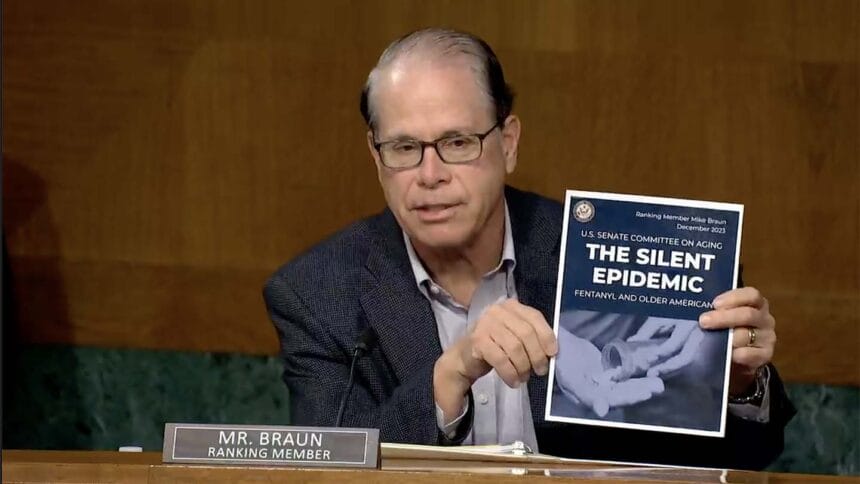
A Congressional hearing and a stunning new report issued by a government watchdog Thursday show seniors need more help accessing care for substance use disorders, finding providers willing to treat them and getting required services covered.
Sen. Bob Casey (D-PA), chairman of the Senate Special Committee on Aging, noted that nearly 4 million older adults reported having a substance use disorder in 2022, with 1.8 million of those involving drug use. Mortality from drug overdoses among seniors also more than tripled between 2000 and 2022, he added, citing federal data.
“Older adults are not immune to these issues, and this a growing and evolving crisis in America,” Casey said in opening the hearing, which focused both on access to opioids and gaps in care.
“Older adults tend to be overlooked for substance use disorders in typical screenings and prevention efforts, even though they are more susceptible to developing substance use disorders than other age groups and at higher risk of undiagnosed and untreated substance use disorders,” he added. “The people, the problems and the solutions remain largely invisible to our society.”
Nursing homes are increasingly being called on to treat patients with substance use disorders, with both federal regulators and state law enforcement officials reminding facilities that they cannot turn away such patients when they are also in need of skilled care.
Some nursing homes have begun to specialize in providing such care, particularly for opioid-addicted patients requiring administration of suboxone treatments.
OIG keeps focus on needs, treatment access
Thursday’s hearing coincided with the publication of an annual brief from the Health and Human Services Office of Inspector General that examines access to treatment for opioid use disorder and the opioid overdose-reversal drug naloxone.
It found that about 52,000 Medicare enrollees experienced an opioid overdose in 2022. Of the 1.1 million enrollees who have opioid use disorder, just 18% received medication to treat that disorder. In some states, the OIG found far lower access, with Florida the worst with just 6% receiving treatment medication.
While naloxone has been an important tool in addressing the nation’s opioid crisis — one Senate witness credited with “saving countless Americans from death” — it last year became an over-the-counter medication. That could mean less affordable access for some Medicare patients, and the OIG warned CMS to make sure providers know how to educate patients and prepare for additional need.
The OIG report recognized that CMS and the department “had taken a number of actions” to increase access to suboxone and other opioid use disorder treatments.
“However, the low percentage of enrollees receiving medication to treat their opioid use disorder calls for additional action,” the report said.
David Skoczulek, vice president of business development and communications at Connecticut-based iCare Health Network, said providing access to “patient-centered, specialized substance use treatment and care in the skilled nursing setting is critical.”
“Substance use disorder crosses all social and demographic lines,” he added. “The need for these services is not going away and it’s not even appearing to ebb over time. We will be living with the impacts of the opioid epidemic for a very long time in all aspects of healthcare, and skilled nursing care is not an exception. It’s highly prevalent and we will need increasing supports, access and coverage to provide quality care to these individuals.”
Medicare coverage gaps remain
Much of the conversation Thursday revolved around the inability of Medicare-covered seniors to access residential treatment and other services under either traditional or managed care plans.
While commercial insurance providers in the US must provide parity in the way they cover physical health needs and behavioral health needs, the Medicare system has not been changed to reflect that standard.
“Older adults and people with disabilities deserve non-discriminatory coverage of substance use disorder and mental health treatment,” said Deborah Steinberg, senior health policy attorney at the Legal Action Center. “We urge you to ensure that Medicare beneficiaries do not continue to be left behind.”
She pointed to the 2018 SUPPORT Act, which first added coverage of opioid use treatment to Medicare, as the start of improved treatment for opioid use disorder. This year, Congress included coverage of addiction counselors (under the umbrella of mental health counselors) and intensive outpatient treatment in its consolidated appropriations bill.
And CMS has also issued regulatory guidance and coding to make sure beneficiaries have more access to peer support specialists and community health workers, Steinberg noted. The agency also increased Medicare reimbursement for psychotherapy and office-based substance use treatment to “address barriers to provider participation,” Steinberg said.
Nursing homes, however, aren’t paid extra by the federal government for substance use disorder care provided to their residents, despite its additional staffing and safety demands and costly counseling services. State Medicaid plans, however, do in some cases help offset the cost of bringing in behavioral health professionals.
Also Thursday, Sen. Mike Braun (R-IN), the committee’s ranking member, issued a new report emphasizing concerns about the illicit opioid trade and the increasing ways seniors may interact with fentanyl-laced drugs.
“Despite [a] dramatic increase in overdoses due to synthetics, prevention messaging for older adults still reflects traditional concerns about prescription opioid misuse but does not focus on synthetics like fentanyl increasingly infecting drugs taken by older Americans,” the report stated.




